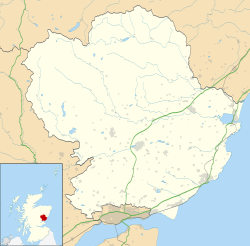| St Vigeans Church | |
|---|---|
| St Vigeans Parish Church, Arbroath | |
 | |
| 56°34′36″N2°35′25″W / 56.57675°N 2.59029°W | |
| Location | Arbroath, Angus |
| Country | Scotland |
| Denomination | Church of Scotland |
| Website | www.stvigeanschurch.org |
| History | |
| Status | Parish church |
| Dedication | Saint Fechin |
| Architecture | |
| Functional status | Active |
| Heritage designation | Category A listed building [1] |
| Clergy | |
| Minister | Rev. Dr Nelu Balaj |
St Vigeans Church is a Church of Scotland parish church, serving the parish of the ancient village of St Vigeans on the outskirts of Arbroath, Angus, Scotland. The church was rebuilt in the 12th century [2] but not consecrated until 1242 by David de Bernham, Bishop of St Andrews. The church underwent some alteration in the 15th century, but suffered very little change following the Scottish Reformation of 1560. A major restoration was carried out in 1871 by the Scottish Victorian architect Robert Rowand Anderson. [1]
